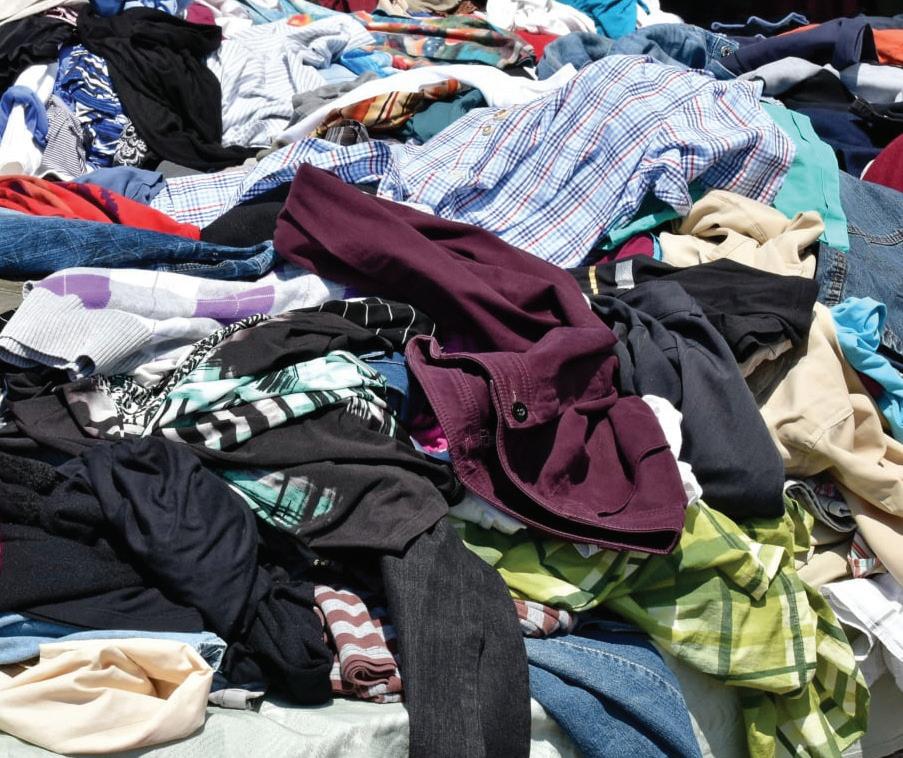
7 minute read
December 2022 Shuttle
by Weavers Way
True Fabric Recycling Requires More Than Secondhand Shops

by Anne Hylden, for the Shuttle
According to a 2017 report published by the Ellen MacArthur Foundation, an organization devoted to promoting a circular economy, 99% of all the clothing in the world eventually makes its way to a landfill, an incinerator or the environment. This number includes the clothes we donate to secondhand stores, many of which end up in dumpsites in the Global South. It also includes clothing that is downcycled into cleaning rags or insulation, which will eventually become trash as well. Only one percent of what we wear is turned back into new clothes.

Globally, we create 100 million tons of textile waste each year, according to the BBC article "Why Clothes Are So Hard to Recycle," published in 2020. That's the weight of 2,000 Titanics. Imagine if we could repurpose that material into items of similar or higher value, so it never has to get thrown away. We would reduce waste, extract fewer resources from the Earth, and curb the fashion industry’s pollution impact. And we would be one step closer to a circular economy, where trash becomes a valuable input for manufacturing.
There are a few methods currently in use for recycling clothing in a way that retains its material value and converts it into new fabric. Unfortunately, they all require a highly pure feedstock — the industrial term for the stuff that goes into a production plant. Typically, the textiles that get recycled this way must be composed of more than 90% of one fiber type. But obtaining such purity is difficult when it comes to clothing.
"Think about what's in your closet. It's just filled with so many blends," said Pamela Retseck, the owner of Paper Chase (Diversified) of Woodstock, NY. Her company helps businesses find recycling solutions for their waste. She added that there are currently no commercially viable options for recycling blended fabrics but that researchers are working on the problem.
The Fundamentals of Fabric
Fabric is made of fibers, which come in two main types. Synthetic fibers such as polyester, nylon and acrylic are made from petroleum. They are essentially plastic, but thin. (In fact, polyester clothing is made of the same material as PET bottles.) Natural fibers come from plants or animals and include cotton, hemp, wool and silk.
All the above are materials known as polymers, which consist of long chains of repeating molecular units. For example, the polymer in cotton is cellulose, each unit of which is built from thousands of individual sugar molecules. Synthetic cellulosic materials include lyocell (formerly known as Tencel) and viscose (formerly known as rayon). They are made by chemically treating wood pulp — which contains lots of cellulose — and
extruding it into fibers to mimic cotton.
The most common mixed fabric material is a polyester-cotton blend. Since it would be impractical to pick the fibers apart one by one for recycling, scientists are turning to chemistry for solutions. They can utilize the different properties of the combined fibers to dissolve one but leave the other intact.
A 2022 review article in the academic journal Polymers summarizes many of the recent successes in this area. Possible separation techniques include breaking down the cellulose in cotton with enzymes, acid or special solvents. This creates either a cellulose powder or a sugary syrup that can be washed away from the polyester, which remains unchanged. Then the pure polyester can be melted and reformed, and the cellulose powder can become feedstock for lyocell. If the separation treatment breaks the cotton all the way down into small sugar molecules, that sugar can be burned for energy, fermented into ethanol or used to make bio-based plastics.
But while these methods work well in the lab, scaling them up for industrial recycling is a huge challenge ,according to Jack Payne, a graduate student at the University of Bath who studies plastic recycling methods. He explained that having large amounts of material makes it difficult to get everything mixed and heated evenly. In addition, textiles themselves are complex. Along with the prevalence of blended fibers, clothing also has tags and buttons that need to be removed, plus dyes and trace chemicals that could potentially ruin the process.
Can Fabric Recycling Be Profitable?
A few startup companies are working to take these lab-based separation techniques into the real world. Circ, which is building a pilot plant in Danville, VA, uses heat and high pH to break down the polyester in a blended fabric into small molecules, leaving the cotton as a solid. Worn Again Technologies, a UK company, plans to uti-
lize a solvent separation process for poly-cotton blends. And BlockTexx in Queensland, Australia is figuring out how to turn large amounts of clothing waste into recycled polyester and cellulose powder.
These companies hope that the technology they develop will move society toward a more circular future, but they are all still in the planning and building stages. Their first big challenge will be developing a process that can stand up to contamination, due to the composite nature of most clothing materials.
Their second big challenge will be to ensure that the process is profitable, which Retseck said hasn’t always been the case. “At the end of the day, the pellet or whatever they make is worth a nickel a pound; it cost them 30 cents a pound to do it,” she said. “The economics of it often do not work.”
Payne has ideas for making recycling more profitable in the short term. Chemists like him can turn polyester into new molecules, such as building blocks for drugs. This process could upcycle waste into products with higher value-added products. He sees chemical recycling as one tool in “a portfolio of waste management strategies” that will help get us to a circular economy. But this will require a mindset adjustment.
“If we're shifting to a circular economy perspective, then waste is actually a useful feedstock that we can do something with,” he said.
For her part, Retseck would like to see a mindset shift to “designing for the afterlife.” If we consider what will happen to a garment at the end of its use, we could create much better future recycling flows. For example, a brand called Napapijri created the Infinity Jacket, which is 100% recyclable because every component is made of one type of nylon. That includes the zippers, filling and embellishments, so that no separation, physical or chemical, is required for processing.
“It’s such a tiny bit,” she said of the Infinity Jacket. “But it’s the beginning.”
Finally, some policy adjustments, such as Extended Producer Responsibility, could make a huge difference. According to EPR thinking, manufacturers should bear the cost of collecting, recycling or disposing of the products they make. Maine, Oregon, Colorado and California have recently passed EPR laws targeting plastic and other packaging waste.
“I do feel the industries themselves have the responsibility of dealing with the stuff they manufacture,” Retseck said. “If you produce something, you do need to have an end-of-life solution for it, or we're just sending it back. Here, you're getting it whether you want it or not. You made it.”
Phone: 215-356-8061 Email: jfrankphd@gmail.com www.JeremyFrankAssociates.com




